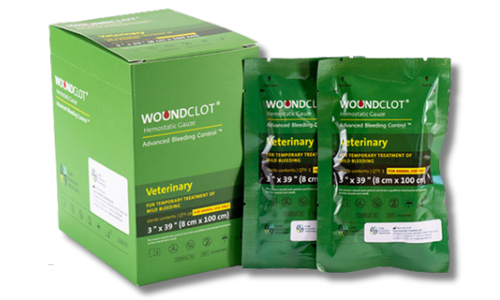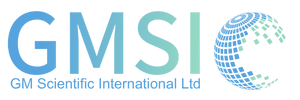About WoundClot™ Veterinarian

WoundClot™ Veterinarian is an advanced hemostatic gauze designed for effective control of mild to severe bleeding across a wide range of veterinary applications.
- Effective in patients on anticoagulant/antiplatelet therapy
- Effective in patients in Coagulopathy
- Provides effective hemostasis without the need for manual compression
- Exhibits a high safety profile with no known contraindications, except in cases of hypersensitivity to the device’s constituent materials.
- Suitable for application to any external area of the body
- Available in multiple sizes and designed to conform effectively to diverse anatomical contours
- Demonstrates zero toxicity, with no harmful side effects or residual by-products
- Designed for ease of use, requiring minimal training for effective application
Available Sizes
| 10 cm x 10 cm ( 4” x 4” ) |
8 cm x 20 cm ( 3” x 8” ) |
8 cm x 100 cm ( 3” x 39” ) |
|
|---|---|---|---|
| Product Number | 101611901 | 101682901 | 101681901 |
| Description | Tear-open package | Tear-open package | Tear-open package |
| Pieces Per Box | 10 | 10 | 10 |
How It Works
When applied to a bleeding site, WoundClot™ quickly transforms from a dry, flexible gauze into a dense, durable, and expanding 3D gel matrix. This stable and adaptable structure supports fast, reliable hemostasis through multiple mechanisms of action.
Absorption
WoundClot™’s 3D gel matrix absorbs up to 2,500% of its weight in blood and remains actively absorbent for up to 24 hours.
Adhesion
WoundClot™’s flexible 3D gel matrix conforms to and adheres securely to the surrounding tissue within the wound site.
Aggregation
WoundClot™ forms a 3D gel matrix that facilitates the local aggregation of platelets, red blood cells and clotting factors, establishing an optimal microenvironment for accelerated hemostasis.
Activation
WoundClot™’s advanced functional molecular groups stimulate the coagulation cascade by activating key clotting factors, specifically Plasma Thromboplastin Antecedent (Factor XI) and Hageman Factor (Factor XII), converting them from their inactive forms (XI and XII) to active forms (XIa and XIIa). This targeted activation enables rapid and stable hemostasis.
FAQ
WoundClot™ is composed of cellulose – a natural, plant-derived fibre, uniquely engineered into a Non-Oxidised, Non-Regenerated Cellulosic Structure (NONRCS). Unlike conventional cellulose-based hemostatic agents, which are produced using outdated oxidation processes that degrade the material’s integrity, WoundClot™ maintains the full functional capacity of cellulose. This advanced structure enhances its ability to absorb blood, adhere to wound surfaces, and support rapid and effective hemostasis.
WoundClot™ is composed entirely of cellulose, a natural plant-based fibre. Unlike traditional hemostatic agents that rely on added active ingredients, such as kaolin, chitosan, collagen, silica, or thrombin, WoundClot™ is inherently hemostatic due to its patented manufacturing process. This unique process transforms the cellulose into a bioactive structure that promotes hemostasis without the need for any pharmacological additives.
Mineral-based hemostatic agents typically consist of non-resorbable, non-woven fibres impregnated with an active substance such as kaolin – an inorganic white clay derived from the natural breakdown of feldspar or other clays. These products rely on a single mechanism of action: activation of Factor XII (Hageman Factor). Their effectiveness generally requires the application of firm manual pressure for 3 to 5 minutes.
In contrast, WoundClot™ employs multiple mechanisms of action for superior hemostatic performance. These include:
Rapid absorption of wound exudate
Conformable expansion and strong adherence to wound surfaces
Aggregation of platelets, red blood cells, and clotting factors to promote clot formation
Activation of both Factor XI (Plasma Thromboplastin Antecedent) and Factor XII (Hageman Factor)
Additionally, WoundClot™ remains actively absorbent for up to 24 hours in the wound, supporting sustained hemostasis without the need for prolonged compression.
Chitosan-based hemostatic agents consist of non-resorbable, non-woven fibres impregnated with chitosan – a positively charged polysaccharide derived from the exoskeletons of shellfish such as crabs, lobsters, and shrimp. These products operate through a single mechanism of action, attracting negatively charged red blood cells (RBCs) to initiate clot formation.
In contrast, WoundClot™ offers a multi-mechanistic approach to hemostasis:
Rapid absorption of wound exudate
Conformable expansion and firm adherence to the wound site
Aggregation of platelets, RBCs, and clotting factors to enhance clot formation
Activation of two critical clotting factors: Factor XI (Plasma Thromboplastin Antecedent) and Factor XII (Hageman Factor)
WoundClot™ also remains actively absorbent for up to 24 hours, providing sustained hemostatic support and superior performance without the allergenic risk associated with shellfish-derived products.
Oxidized Regenerated Cellulose (ORC) hemostatic agents are based on legacy technology developed over 75 years ago. These materials often adhere unintentionally to surgical gloves and instruments rather than to wound surfaces, compromising their effectiveness. While some ORC products are FDA Class III implantable devices, their Instructions for Use frequently recommend removal when feasible due to the elevated risk of infection or adverse tissue reactions.
ORCs are not intended for use in cases of persistent or high-volume bleeding.
In contrast, WoundClot™ is the world’s only Non-Oxidized, Non-Regenerated Cellulosic Structure (NONRCS) hemostatic agent. It is:
Highly absorbent, capable of absorbing up to 3,000% of its weight in fluid
Strongly adherent to wound surfaces, even under high-pressure bleeding conditions
Actively absorbent for up to 24 hours, supporting sustained hemostasis
Engineered for reliable control of mild, moderate, and severe bleeding
This modern structure ensures superior clinical performance without the limitations of traditional ORC-based technologies.
WoundClot™ employs a multi-modal mechanism of action that sets it apart from all other hemostatic agents currently available. Upon contact with blood, its patented Non-Oxidised, Non-Regenerated Cellulosic Structure (NONRCS) rapidly transforms into a cohesive, expanding gel that adheres securely to wound surfaces. This gel matrix promotes localized clot formation without the need for manual compression.
WoundClot™ is exceptionally absorbent, capable of absorbing up to 3,000% of its weight in fluid, and remains actively absorbent for up to 24 hours. With a strong safety profile, it is suitable for use on all external anatomical sites and is designed for ease of use, requiring minimal training for effective application.
Yes. Activation of the clotting cascade is one of the key mechanisms through which WoundClot™ achieves rapid hemostasis. The gauze is engineered with specialised functional molecular groups that directly activate Factor XI (Plasma Thromboplastin Antecedent) and Factor XII (Hageman Factor), initiating and accelerating the intrinsic pathway of coagulation.
WoundClot™ features one of the fastest bioresorption profiles among surgical hemostatic agents. Its bioabsorbable structure is gradually broken down and safely resorbed by the body, minimising the risk of foreign body reactions and eliminating the need for removal.
WoundClot™ can be easily removed by lifting the stabilized clot from the wound site. Its atraumatic removal does not induce rebleeding and any residual gel can be gently irrigated and cleared without difficulty, supporting a clean wound environment and optimal healing conditions.
WoundClot™ has a shelf life of 5 years, offering long-term storage stability for hospitals, emergency services and military medical supplies.
Yes. WoundClot™ is effective in patients undergoing antiplatelet or anticoagulant therapy. Its efficacy is supported by multiple independent mechanisms of action –including fluid absorption, clotting factor activation, and cellular aggregation – allowing it to promote hemostasis even when normal coagulation pathways are pharmacologically inhibited.
